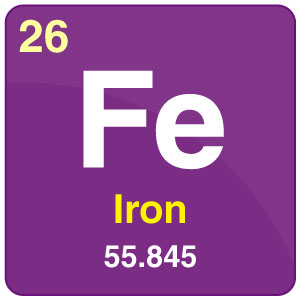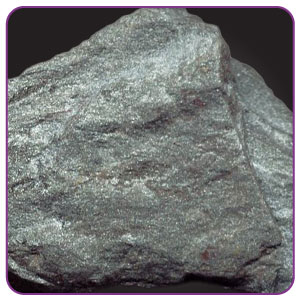
| Iron Symbol | Fe |
| Iron Atomic Number | 26 |
| Iron Atomic Mass | 55.85 g.mol -1 |
| Discovered by | The Ancients |

Chemical Properties Of Iron
| Group | 8 | Melting point | 1536 °C |
| Period | 4 | Boiling point | 2861 °C |
| Block | d | Density (g cm−3) | 7.8 g.cm-3 at 20°C |
| Atomic number | 26 | Relative atomic mass | 55.845 |
| State at 20°C | Solid | Key isotopes | 56Fe |
| Electron configuration | [Ar] 3d64s2 | CAS number | 7439-89-6 |
| ChemSpider ID | 22368 | ChemSpider is a free chemical structure database | |
What is iron?
- Iron is a metal, an element of group VIII of the periodic table. It is a lustrous, ductile, malleable, silver-grey in colour. It is the tenth most abundant element in the universe. It is found in a major amount at the core of the Earth in a molten form.
The element iron (Fe), for example, can be made into a nail. If you cut the iron nail in half, it is still the element iron. If you continue to cut the nail until it is so small that you can barely see it, you are still going to be holding the element iron.
Melting Point of Iron ( Fe)
The melting point of iron ( Fe) at the outer (liquid) core-inner (solid) core (330 GPa) pressures at a depth of 5150 km in the Earth was suggested to provide an absolute temperature limit. Initial research on the melting ties in system Fe-Ni-O-S below 20 GPa indicated that geochemically plausible iron alloys significantly reduced the Fe solidus from 2200 to 1150K.
Alloy add-ons also suppress the melting range (lower). Pure iron ( Fe) has a fixed melting point of 1535 ° C, chromium ( Cr) of 1890 ° C and nickel (Ni) of 1453 ° C compared to 1400-1450 ° C for stainless steel of type 304.
Iron – Heavy Metal
Iron is a chemical element in the periodic table that has the symbol Fe and atomic number 26. Iron is a group 6 and period 4 metal. Iron is notable for being the final element produced by stellar nucleosynthesis, and thus the heaviest element which does not require a supernova or similarly cataclysmic event for its formation. It is, therefore, the most abundant heavy metal in the universe.
Iron is the most abundant metal on Earth and is believed to be the tenth most abundant element in the universe. Iron is also the most abundant element making up the Earth; the concentration of iron in the various layers of the Earth ranges from high at the inner core to about 5% in the outer crust, it is possible the Earth’s inner core consists of a single iron crystal although it is more likely to be a mixture of iron and nickel; a large amount of iron in the Earth is thought to contribute to its magnetic field. Iron is a metal extracted to its magnetic field. Iron is a metal extracted from iron ore and is hardly ever found in the free state.
Iron is used in the production of steel which is not an element but an alloy, a solution of different metals and some non-metals particularly carbon.
Uses of iron
- It is used to manufacture steel and also used in civil engineering like reinforced concrete, girders etc.
- Iron is used to make alloy steels like carbon steels with additives such as nickel, chromium, vanadium, tungsten, and manganese.
- These are used to make bridges, electricity pylons, bicycle chains, cutting tools and rifle barrels.
- Cast iron contains 3–5% carbon. It is used for pipes, valves, and pumps.
- Iron catalysts are used in the Haber process for producing ammonia.
- Magnets can be made of this metal and its alloys and compounds.
Physical Properties of Iron
- It rusts in damp air, but not in the dry air.
- It dissolves readily in dilute acids.
- At room temperature, this metal is in the form of ferrite or α-form.
- At 910°C, it changes to γ-iron, which is much softer in nature.
- It melts at 1536°C and boils at 2861°C.
- Being a metal is magnetic in nature.
Why is Iron different from Other Elements?
The difference is the number of protons found in the nucleus of the atoms. The number of protons makes each element unique, so they are organized by these numbers on the periodic table. The number of protons that are found in an atom of an element is called the atomic number.
On the periodic table, this number is found above the element symbol. Iron has twenty-six protons, so its atomic number is 26. The fact that iron has twenty-six protons in its nucleus is what makes it iron. If one proton were added to the nucleus of an iron giving it twenty-seven protons it would be an entirely different element. Adding another proton would create the atom of the element cobalt.
Taking away one of iron’s protons results in man manganese (Mn), which has twenty-five protons in its nucleus. Changing the number of protons creates an entirely different element.
Certain Facts About Iron
- An average human body contains about 4 grams of this iron in the form of haemoglobin, in the blood.
- It is the 6th most common element in the universe.
- There are four known allotropic forms of iron.
Recommended Videos

Frequently Asked Questions – FAQs
What is the importance of the element iron?
- It is a building block of steel
- It helps in transferring oxygen in the blood and
- It also helps in the nourishment of plants.
What is the atomic number of iron?
Iron is a chemical element with atomic number 26 and symbol Fe. It is a metal that belongs to the periodic table’s first transition series and group 8. It is the most common element on Earth by mass, forming much of the outer and inner core of Earth.
Write the electronic configuration of iron.
What is the boiling point of iron?
The boiling point of iron is 2861 °C. Steel is just the iron component refined to regulate the carbon quantity. Iron melts from the surface at about 1750 ° F (1510 degrees C). Steel also drops at 1370 degrees C.
Why does iron have a high melting point?
It is necessary to overcome the attraction between the metal ions and the dislocated electrons to melt or boil a metal. Such attractive forces are solid, so high melting and boiling points are found in metals.
What are the properties of iron?
Iron is a metal which is lustrous, ductile, malleable, silver-gray (periodic table group VIII). In four distinct crystalline shapes, it is recognised to occur. In humid weather, the iron rusts, but not in dry air. It is easily dissolved in dilute acids.
What are the types of iron?
I plain iron, (ii) wrought iron, (iii) cast iron, (iv) pig iron, and (v) direct reduced iron are classified as such materials. These iron types are mentioned in Fig 1. Pure iron is a term used to denote fresh iron manufactured in an electric arc furnace where adequate temperatures can be reached to melt the iron.
What are the properties and uses of iron?
It is a smooth, greyish metal, rusting in the humid weather. Iron is an enigma – it quickly rusts but it remains the most significant of all metals. Of all the metal processed today, 90 per cent is iron. The bulk is used for steel construction, used in construction engineering (reinforced concrete, girders, etc.) and manufacturing.
Read more:

it was very help for me and i was strugling in science but now its so easy to understand thx .